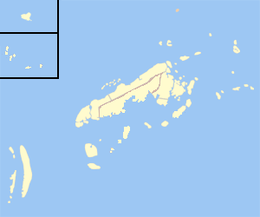geo.wikisort.org - Island
Tawitawi Island (also spelled Tawi Tawi or Tawi-Tawi) is a Philippine island in the Sulu Archipelago between the Sulu Sea and Celebes Sea, about 64 kilometres (40 mi) east of Borneo.[2] It is the main island of Tawi-Tawi Province.
 Tawi-Tawi province map showing Tawi-Tawi Island and smaller outlying islands | |
 Tawitawi Location within the Philippines | |
| Geography | |
|---|---|
| Coordinates | 05°12′N 120°00′E |
| Archipelago | Sulu Archipelago |
| Adjacent bodies of water | |
| Area | 580.5 km2 (224.1 sq mi)[1] |
| Length | 55 km (34.2 mi)[2] |
| Width | 23 km (14.3 mi)[2] |
| Coastline | 152.2 km (94.57 mi)[1] |
| Highest elevation | 552 m (1811 ft)[1] |
| Highest point | Mount Sibangkat |
| Administration | |
Philippines | |
| Region | BARMM |
| Province | Tawi-Tawi |
| Municipalities |
|
| Largest settlement | Bongao (pop. 116,118) |
| Demographics | |
| Population | 82,582 (2010)[3] |
| Pop. density | 142.3/km2 (368.6/sq mi) |
Tawitawi has an area of 580.5 square kilometres (224.1 sq mi), making it the 21st largest island of the Philippines, and the 3rd largest island in the Sulu Archipelago (after Basilan and Jolo). It has a shoreline length of 152.2 kilometres (94.6 mi), and a maximum elevation of 549 metres (1,801 ft).[1]
Tawitawi Island is of volcanic origin and irregular in shape, about 55 kilometres (34 mi) long and between 10 to 23 kilometres (6.2 to 14.3 mi) wide. It is hilly and heavily wooded, with splashes of white sandy beaches and rock-bound coasts.[2]
The island is subdivided into 4 municipalities (Bongao, Languyan, Panglima Sugala, and Tandubas). The inhabitants are mostly Sama people, speaking Sama–Bajaw languages and of Muslim conviction.[2]
References
- "Islands of Philippines". Island Directory. United Nations Environment Programme. Retrieved 29 August 2014.
- "Tawi Tawi". www.britannica.com. Encyclopædia Britannica, Inc. Retrieved 29 August 2014.
- "Total Population by Province, City, Municipality and Barangay: as of May 1, 2010" (PDF). 2010 Census of Population and Housing. National Statistics Office. Retrieved 1 September 2014.
External links
 Geographic data related to Tawi-Tawi Island at OpenStreetMap
Geographic data related to Tawi-Tawi Island at OpenStreetMap
На других языках
[de] Tawi-Tawi Island
Tawi-Tawi Island[1], auch Tawitawi Island oder Tawi Tawi Island genannt, ist eine bewohnte Insel im Südwesten des philippinischen Sulu-Archipels, gelegen im Grenzbereich von Sulusee und Celebessee.- [en] Tawi-Tawi Island
Другой контент может иметь иную лицензию. Перед использованием материалов сайта WikiSort.org внимательно изучите правила лицензирования конкретных элементов наполнения сайта.
WikiSort.org - проект по пересортировке и дополнению контента Википедии